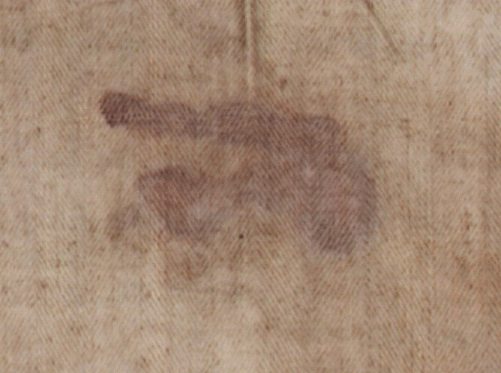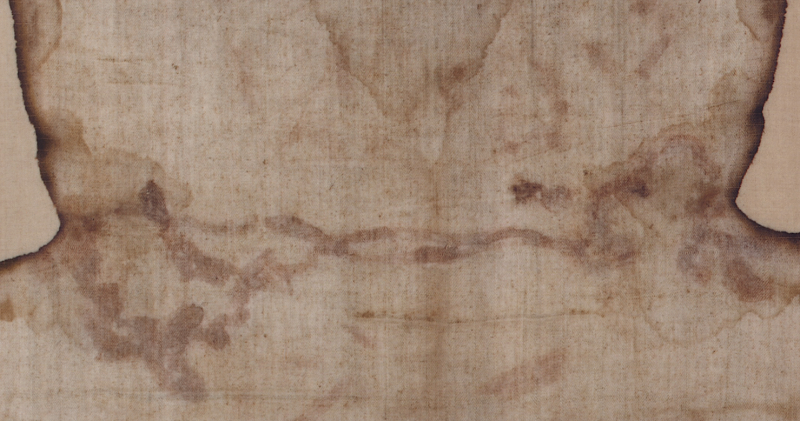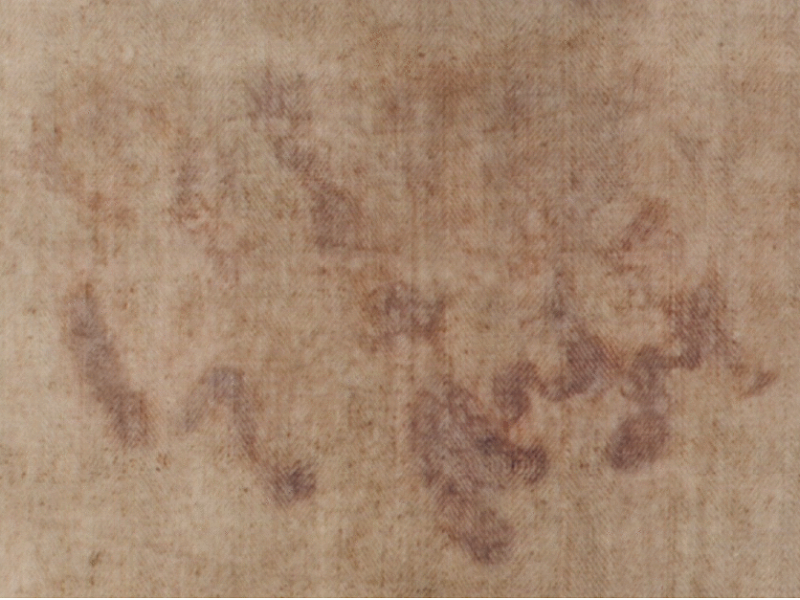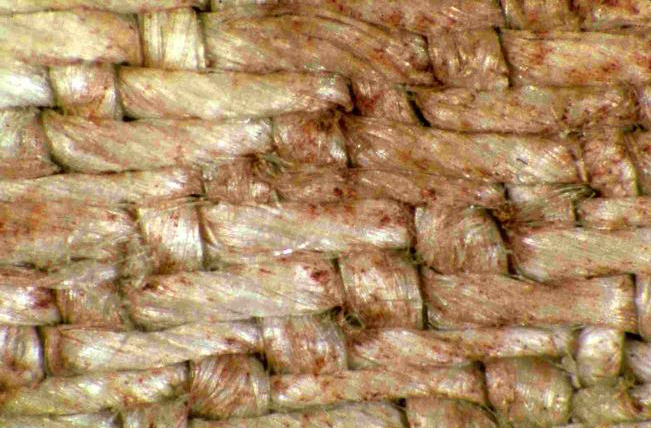Copyright © Stephen E. Jones[1]
This is part #24, "The man on the Shroud: Blood clots intact," of my series, "The evidence is overwhelming that the Turin Shroud is Jesus’ burial sheet!" For more information about this series, see the "Main index #1" and "The man on the Shroud #8." Emphases are mine unless otherwise indicated.
[Main index #1] [Previous: Real human blood #23] [Next: No image under blood #25]
- The man on the Shroud #8
- Blood clots intact #24
Introduction The bloodstains on the Shroud are comprised of intact[2], unbroken[3], unsmeared[4], clots[5].
[Above (enlarge): "Photomicrograph ... Dense blood at the small of back ... Mark Evans 1978"[6]. See also the photomicrograph at 03Jun17. These do not show individual blood clots on the Shroud in close-up detail but I am unaware of any that do. The photomicrograph above is magnified 18 times[7]. It measures ~105 x ~72 mm on my computer screen. That means its actual size on my screen would be ~105/18 x ~72/18 mm = ~5.8 x ~4 mm or ~0.22 = ~7/32 in. x ~ 0.16 = ~5/32 in. See below photo of actual size. Look at a ruler and try to imagine a medieval forger painting
![]() [Left: The above photomicrograph reduced 18 times (651 x 428 pixels to 26 x 24 pixels).]
[Left: The above photomicrograph reduced 18 times (651 x 428 pixels to 26 x 24 pixels).]
the above bloodstains, with real human blood (because that is what they are - see #23), on an area ~5.8 x ~4 mm (or ~7/32 x ~5/32 in.), and repeating that for each and every blood area on the Shroud! See future below Dr. Pierre Barbet (1884–1961) on the impossibility of a medieval forger painting the Shroud's bloodstains.]
The blood on the Shroud is in clots The bloodstains on the Shroud 
[Above (enlarge): Close up of the `reversed 3' bloodstain on the left forehead of the man on the Shroud, and showing the crown of thorns puncture wound from which the blood originated[8]. As can be seen, the upper majority of this clot is intact, while part of its lower minority has presumably flaked off over a foldline. Since this clot, like all of them, would have adhered to both the man's skin and to the cloth, if the Shroud had been removed by human agency, the clot would be patchy along its entire length as when a bandage is removed from a bloody wound (see below).]
are clots[9]. These clots are blood that has congealed on the skin while flowing over it[10]. Each one of them has a thickened edge[11], a depressed centre[12] and a retraction serum halo or ring[13], as all blood clots do[14].
The blood clots are intact The blood clots on the Shroud are 
[Above (enlarge)[15]: The blood clots from the nail exit wound in the left hand. Again the top clot is intact even if part of the lower one has flaked off. The two angles are due to the blood dripping down under gravity from the arm's two positions on a cross, pushing up and slumping down, that a crucifixion victim must continually make to inhale and exhale (see 03Jun17).]
intact[16]. But if a dressing is placed over the moist blood of a wound and after the blood has dried the dressing is removed, only part of the blood will transfer to the dressing, the rest will still adhere to the skin[17]. This means the Shroud separated from the man's body in a special way[18], without it being unwrapped[19], or by any other human agency[20]. This is further evidence that the man is Jesus and the special separation of the cloth from His body occurred at His resurrection (see below).
The blood clots are unbroken The blood clots on the Shroud are not broken[21], even on the man's back where there would have been
[Above (enlarge)[22]: Large mass of clotted blood and lung fluid at the small of the man's back (rotated upright) which came from the spear in the man's side (at left). As can be seen, even this large mass of clotted blood that the body was lying on is unbroken and unsmeared.]
maximum pressure[23].
The blood clots are unsmeared The blood clots on the Shroud are not smeared[24], again even on the back (see above) where the body
[Above (enlarge)[25]: Blood clots in the man's hair at the back of his head (rotated 180 degrees). As can be seen, even these are not smeared.]
lay on the Shroud[26]. That is, except for the shoulder blades where a crossbeam carried by the man on his right shoulder across his upper back (see 17Nov15) has smeared those scourge mark clots[27]. Other- wise, again (see above) this means the cloth separated from the body not by human agency[28]. So again (see above) this is further evidence that the man on the Shroud is Jesus and the separation of the Shroud's cloth and body occurred at His resurrection! (again see below)
Problem for the forgery theory (see previous three: #21, #22 and #23). As we saw in #23, no known artist used blood to depict blood[29]. Then see the above photo of the actual tiny size of Mark Evans' photomicrograph of blood clots from a back area of the Shroud. Clearly no medieval forger could paint with real, human blood (because that is what they are) the fine details (including their near-invisibility except under ultraviolet light[30] which was only discovered in 1801[31]) of the thousands of such tiny blood clots that must be on the Shroud. In fact no artist in history has painted blood in a clotted form: when artists have depicted blood it has always been as free-flowing[32]. At the time the Shroud entered undisputed history at Lirey, France in c.1355, no one had the medical knowledge of the details of blood clotting, to even consider painting the Shroud's blood clots in the forensically correct manner that they are on the Shroud[33]. From the more than one hundred tiny scourge marks[34] to the large lesions, the bloodstains on the Shroud are clots which show the characteristics of the process of syneresis (when serum drains from a contracting clot of blood) that occurs when blood coagulates following bleeding[35]. But it was not until the 19th century that those details of blood clotting began to be discovered[36]! And added to all these above problems of the forgery theory, the blood was on the cloth before the image (see future part #25)!
Evidence of Jesus' resurrection As we saw above (here and here), that the blood clots which comprise the bloodstains on the Shroud are intact, unbroken and unsmeared, means that the cloth separated from the man's body in a special way, not by human agency or any other known means. That the Man on the Shroud is Jesus (as the evidence overwhelmingly indicates), this special separation of the Shroud's cloth and body is explained by His resurrection[37]! We have already seen in #21 of this series that that there are no signs of decomposition on the man's image, meaning that he was not in contact with the Shroud for more than three days.. And we saw in #22 that the man's finger and hand bones, teeth, skull, spinal column and leg bones are x-ray images. And, as previously mentioned, in future part #25 we will see that the blood was on the cloth before the image!
I conclude with the following quotes, which say it better than me:
"In the end, Vignon couldn't figure out how the body had exited the shroud without distorting the picture-perfect blood stains. If they'd been wet, they would have been ruined when the cloth was removed. If dry, they would have ripped the cloth. Was this possible proof of resurrection? Vignon couldn't say. Such a thing was beyond scientific inquiry. But he also couldn't rule it out. After all, Christian tradition said the resurrection had happened, and Vignon could not come up with another explanation. Was he to believe that a string of unfathomable coincidences had occurred and seemingly impossible tasks had been performed to create both the body images and the differently created blood images? Or was it more probable that the body that had once been in the shroud had belonged to Jesus, to whom history says the things observable in the images actually happened?"[38]
"... a corpse covered with wounds lay for some hours in this shroud. Nothing will explain to us how it left it, while leaving on the shroud a fine and unblemished impression of the body and the marks of its bleeding. A man would not be able to remove the body of another, without destroying them. It is certain that this Body, in its glorious Resurrection, could leave the shroud with the same ease as when it entered the cenacle [upper room] ... `when the doors were shut.' [Jn 20:19] This final difficulty brings us to what is, humanly speaking, more or less a physical impossibility. Science at this point can do no more than keep silence, for it is outside its domain. But the man of learning at least has a glimpse that here is a palpable proof of the Resurrection" (emphasis original)[39]
"When I had published the first edition of les Cinq Plaies ["The Five Wounds of Christ"], I went to the Ecole pratique to read it to my old friend, Professor Hovelacque. He was devoted to the subject of anatomy, which he taught to the faculty in Paris, but he was far from being a believer. He approved of my experiments and conclusions with growing enthusiasm. When he had finished reading he put down my booklet, and he remained silent for a short while in a state of meditation. Then he suddenly burst out with that fine frankness on which our friendship had been built up, and exclaimed: `But then, my friend ... Jesus Christ did rise again!' Rarely in my life have I known such deep and happy emotion as at this reaction of an unbeliever when faced with a purely scientific work, from which he was drawing incalculable consequences. He died a few months later, and I dare to hope that God has rewarded him." (emphasis original)[40]
Continued in part #25 of this series.
Notes
1. This post is copyright. I grant permission to quote from any part of this post (but not the whole post), provided it includes a reference citing my name, its subject heading, its date and a hyperlink back to this post. [return]
2. Wuenschel, E.A., 1954, "Self-Portrait of Christ: The Holy Shroud of Turin," Holy Shroud Guild: Esopus NY, Third printing, 1961, pp.51-52; Bulst, W., 1957, "The Shroud of Turin," McKenna, S. & Galvin, J.J., transl., Bruce Publishing Co: Milwaukee WI, pp.74,144; Stevenson, K.E. & Habermas, G.R., 1981, "Verdict on the Shroud: Evidence for the Death and Resurrection of Jesus Christ," Servant Books: Ann Arbor MI, pp.156, 218; Morgan, R., 1982, "Shroud Symposium, New London," Shroud News, No 11, February 1982, pp.3-10, 6; Habermas, G.R., 1984a, "Ancient Evidence for the Life of Jesus," Thomas Nelson: Nashville TN, p.159; Habermas, G.R., 1984b, "Turin, Shroud of ," in Elwell, W.A., ed., "Evangelical Dictionary of Theology," Baker Book House: Grand Rapids MI., 1990, Seventh printing, p.1116; De Vincenzo, V., 1994, "12 Reasons Why I Cannot Accept the Carbon-14 Test Results on the Holy Shroud of Turin," Shroud News No 82, April, pp.3-13, 8); Barbet, P., 1987, "Proof of the Authenticity of the Shroud in the Bloodstains: Part II," Shroud Spectrum International, No. 23, June, pp.3-15, 14. [return]
3. Stevenson & Habermas, 1981, p.156; Morgan, 1982, p.6; Cruz, 1984, p.53; Antonacci, 2000, p.33. [return]
4. Stevenson & Habermas, 1981, p.156; Morgan, 1982, p.6; Cruz, J.C., 1984, "Relics: The Shroud of Turin, the True Cross, the Blood of Januarius ... : History, Mysticism, and the Catholic Church," Our Sunday Visitor: Huntington IN, p.53; De Vincenzo, 1994. "12 Reasons Why I Cannot Accept the Carbon-14 Test Results on the Holy Shroud of Turin," Shroud News No 82, April, pp.3-13, 8; Antonacci, M., 2000, "Resurrection of the Shroud: New Scientific, Medical, and Archeological Evidence," M. Evans & Co: New York NY, p.33. [return]
5. Barbet, 1953, pp.28-29; Borkan, M., 1995, "Ecce Homo?: Science and the Authenticity of the Turin Shroud," Vertices, Duke University, Vol. X, No. 2, Winter, pp.18-51, 27. [return]
6. Lind, A.C. & Antonacci, M., 2015, "Hypothesis that Explains the Shroud’s Unique Blood Marks and Several Critical Events in the Gospels," Shroud of Turin: The Controversial Intersection of Faith and Science Conference, October 9-12, 2014, St. Louis, Missouri. [return]
7. Adler, A.D., 2000c, "Chemical and Physical Aspects of the Sindonic Images," in Adler, A.D. & Crispino, D., ed., 2002, "The Orphaned Manuscript: A Gathering of Publications on the Shroud of Turin," Effatà Editrice: Cantalupa, Italy, pp.10-27, 15. [return]
8. Latendresse, M., 2010, "Shroud Scope: Durante 2002: Face Only Vertical," Sindonology.org. [return]
9. Barbet, 1953, p.28. [return]
10. Barbet, 1953, p.28. [return]
11. Antonacci, 2000, p.26; Adler, 2000c, p.12. [return]
12. Wuenschel, 1954, p.36; Antonacci, 2000, p.26. [return]
13. Heller, J.H. & Adler, A.D., 1981, "A Chemical Investigation of the Shroud of Turin," in Adler & Crispino, 2002, pp.34-57, 44; Antonacci, 2000, p.26; Adler, 2000c, p.12; Tribbe, F.C., 2006, "Portrait of Jesus: The Illustrated Story of the Shroud of Turin," Paragon House Publishers: St. Paul MN, Second edition, p.141. [return]
14. Ruffin, C.B., 1999, "The Shroud of Turin: The Most Up-To-Date Analysis of All the Facts Regarding the Church's Controversial Relic," Our Sunday Visitor: Huntington IN, p.101; Adler, 2000c, p.12; Oxley, M., 2010, "The Challenge of the Shroud: History, Science and the Shroud of Turin," AuthorHouse: Milton Keynes UK, p.239 [return]
15. Latendresse, M., 2010, "Shroud Scope: Durante 2002: Vertical," Sindonology.org. [return]
16. Bulst, 1957, p.74 [return]
17. Bulst, 1957, pp.74, 144. [return]
18. Bulst, 1957, pp.74, 144. [return]
19. Habermas, 1984a, p.159; Habermas, 1984b, p.1116. [return]
20. Stevenson & Habermas, 1981, p.156. [return]
21. Cruz, 1984, p.52. [return]
22. Latendresse, M., 2010, "Shroud Scope: Durante 2002: Vertical," (rotated 180 degrees), Sindonology.org. [return]
23. Cruz, 1984, p.52. [return]
24. Cruz, 1984, p.52; Antonacci, 2000, p.33. [return]
25. Latendresse, M., 2010, "Shroud Scope: Durante 2002: Vertical," (rotated 180 degrees), Sindonology.org. [return]
26. Cruz, 1984, p.52. [return]
27. Barbet, 1953, pp.98-99; Cameron, J. M., "The Pathologist and the Shroud," in Jennings, P., ed., 1978, "Face to Face with the Turin Shroud ," Mayhew-McCrimmon: Great Wakering UK, p.59; Bucklin, R., 1982, "The Shroud of Turin: Viewpoint of a Forensic Pathologist," Shroud Spectrum International, No. 5, December, pp.3-10; Wilson, I., 1986, "The Evidence of the Shroud," Guild Publishing: London, pp.20-21; Bucklin, R., 1997, "An Autopsy on the Man of the Shroud," Third International Scientific Symposium on the Shroud of Turin, Nice, France, 12 May; Iannone, J.C., 1998, "The Mystery of the Shroud of Turin: New Scientific Evidence," St Pauls: Staten Island NY, p.56; Oxley, 2010, p.172; de Wesselow, T., 2012, "The Sign: The Shroud of Turin and the Secret of the Resurrection," Viking: London, p.123. [return]
28. Stevenson & Habermas, 1981, p.156; Stevenson, K.E. & Habermas, G.R., 1990, "The Shroud and the Controversy," Thomas Nelson Publishers: Nashville TN, p.137. [return]
29. Heller, J.H., 1983, "Report on the Shroud of Turin," Houghton Mifflin Co: Boston MA, p.142; Lavoie, G.R., 2000, "Resurrected: Tangible Evidence That Jesus Rose from the Dead," [1998], Thomas More: Allen TX, p.73. [return]
30. Heller, 1983, pp.185, 202; Case, T.W., 1996, "The Shroud of Turin and the C-14 Dating Fiasco," White Horse Press: Cincinnati OH, p.40; Adler, A.D., 2000b, "Chemical and Physical Characteristics of the Bloodstains," in Adler & Crispino, 2002, pp.129-138, 132; Adler, 2000c, p.14; Antonacci, 2000, p.76; Guerrera, V., 2001, "The Shroud of Turin: A Case for Authenticity," TAN: Rockford IL, p.37. [return]
31. "Ultraviolet: Discovery," Wikipedia, 28 August 2017. [return]
32. Barbet, 1953, p.31; Adler, A.D., 1986, "The Origin and Nature of Blood on the Turin Shroud," in Adler & Crispino, 2002, pp.59-66, 60. [return]
33. Adler, 2000b, pp.129-138, 134. [return]
34. Bucklin, R., 1970, "The Legal and Medical Aspects of the Trial and Death of Christ," Medicine, Science and the Law, January; McNair, P., "The Shroud and History: fantasy, fake or fact?," in Jennings, 1978, p.23; Murphy, C., 1981, "Shreds of evidence: Science confronts the miraculous - the Shroud of Turin," Harper's, Vol. 263, November, pp.42-68, 57; Antonacci, 2000, p.27; Wilson, I. & Schwortz, B., 2000, "The Turin Shroud: The Illustrated Evidence," Michael O'Mara Books: London, p.56; de Wesselow, 2012, p.122. [return]
35. Antonacci, 2000, p.28. [return]
36. "Coagulation: Initial discoveries," Wikipedia, 28 August 2017. [return]
37. Bulst, 1957, p.144; Stevenson & Habermas, 1981, p.157; Stevenson & Habermas, 1990, p.137. [return]
38. Wilcox, R.K., 2010, "The Truth About the Shroud of Turin: Solving the Mystery," [1977], Regnery: Washington DC, pp.19-20. [return]
39. Barbet, 1953, p.29. [return]
40. Barbet, 1953, pp.29-30. [return]
Posted 4 September 2017. Updated 12 July 2025.





2 comments:
What is the distinction between "intact" and "unbroken"?
Henry
>What is the distinction between "intact" and "unbroken"?
I didn't say there was. I was just quoting the various sources.
Stephen E. Jones
----------------------------------
MY POLICIES. Comments are moderated. Those I consider off-topic, offensive or sub-standard will not appear. Except that comments under my latest post can be on any one Shroud-related topic. To avoid time-wasting debate I normally allow only one comment per individual under each one of my posts.
Post a Comment